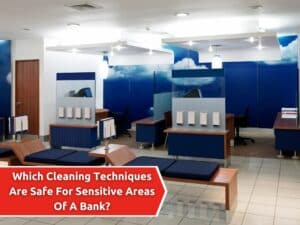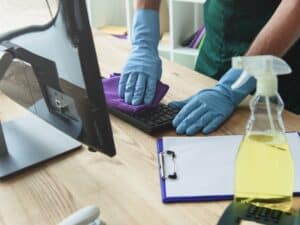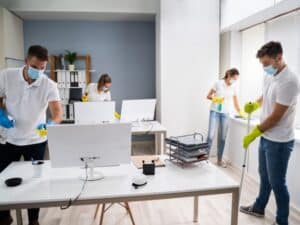Which Cleaning Techniques Are Safe For Sensitive Areas Of A Bank?

Maintaining a clean and safe environment in sensitive bank areas is crucial in today’s world. These areas, including offices, customer service spaces, and high-security rooms, demand special care when it comes to cleaning. Using the wrong products or cleaning techniques can damage delicate equipment, furniture, or materials or even compromise security and hygiene. This article explores the best cleaning practices that ensure safety and efficiency for sensitive bank environments.
Why is it important to use safe cleaning techniques in sensitive bank areas?
The safety and integrity of sensitive bank areas depend on proper cleaning techniques. Banks handle valuable assets and information, and any cleaning methods that aren’t suitable can pose serious risks. Here are a few reasons why it’s essential to use safe cleaning practices:
- Preserving equipment: Electronic devices like computers, servers, and ATMs can be sensitive to moisture and harsh chemicals.
- Preventing security breaches: Sensitive information is often stored in banks, and improper cleaning can accidentally lead to security issues.
- Maintaining aesthetics: Bank furnishings and flooring materials are often high-end and require careful handling to preserve their appearance.
- Ensuring hygiene: Banks are high-traffic areas, and maintaining cleanliness is essential to reduce the risk of illness among employees and customers.
By employing the right cleaning techniques, you can protect both your bank’s assets and reputation.
How can you ensure safety when cleaning high-traffic areas in banks?
High-traffic areas in banks, such as the lobby, hallways, and teller counters, need extra attention because of the constant movement and potential for dirt accumulation. These areas are highly visible, so ensuring they stay spotless while maintaining a safe environment is vital. Here’s how to go about it:
- Use non-slip mats: To prevent accidents when wet floors are cleaned, non-slip mats can be placed strategically.
- Choose non-abrasive cleaners: Avoid harsh chemicals that could damage flooring and surfaces. Instead, opt for gentle, non-abrasive cleaners that won’t leave residues.
- Ensure proper ventilation: Cleaning agents can produce fumes that, when inhaled, may be harmful. Open windows and ensure good airflow while cleaning.
- Schedule cleaning during off-hours: Cleaning high-traffic areas during the bank’s downtime helps minimize disruptions while reducing the risk of accidents.
By following these practices, you can maintain cleanliness without compromising safety.
What cleaning techniques are best for sensitive electronic equipment in banks?
Banks rely on a wide range of electronic devices to operate efficiently, and improper cleaning can cause damage or malfunctions. Here’s how to clean sensitive electronics without causing harm:

- Use microfiber cloths: Microfiber cloths effectively clean electronic surfaces without scratching them. They are also excellent at attracting dust and dirt.
- Avoid moisture: Electronics should never be exposed to liquid. Instead of liquid cleaners, use electronics-specific wipes that are dry or lightly dampened.
- Compressed air: For keyboards, printers, and other equipment with hard-to-reach areas, compressed air can effectively blow away dirt and dust.
- Specialized electronics cleaner: Use cleaning solutions designed specifically for electronics to ensure they don’t leave behind harmful residues or cause damage.
By choosing the right techniques, you ensure that your sensitive electronic equipment stays functional and pristine.
How can you clean delicate furnishings and materials without causing harm?
Banks are often furnished with high-end materials like leather chairs, wooden desks, and delicate carpets. Cleaning these materials requires special care to avoid damage. Here are some tips for cleaning delicate furnishings:
- Leather care: Use leather-specific cleaners and conditioners to avoid drying out or discoloring the material. Always test on a small, inconspicuous area first.
- Wood furniture: Dust regularly using a soft, dry cloth and a wood-specific cleaner for deeper cleaning. Avoid using excess moisture, as it can warp or stain the wood.
- Carpet cleaning: For carpets, consider steam cleaning instead of traditional carpet shampooing. Steam cleaning is gentle on fibers while still offering a deep clean.
- Upholstery: Use gentle, upholstery-specific cleaners to avoid damaging fabric. For stains, spot-clean with a mild detergent mixed with water.
By using the right techniques, your furnishings will remain attractive and intact, while also helping to prevent dust build-up.
How do you prevent cross-contamination during cleaning in sensitive areas?
When cleaning sensitive areas such as bank vaults, customer service desks, or medical offices within banks, preventing cross-contamination is essential for maintaining hygiene. Here are strategies to minimize risks:
- Use color-coded cleaning tools: Assign specific cleaning cloths and mops to particular areas to prevent bacteria from transferring from one part of the building to another.
- Disinfect high-touch surfaces: To reduce the spread of germs, focus on disinfecting high-touch surfaces like doorknobs, light switches, and counters.
- Proper disposal: To avoid contamination, ensure that cleaning cloths and disposables are immediately discarded in the right waste bins.
- Personal Protective Equipment (PPE): Cleaners should wear gloves and masks to protect themselves from harmful substances and prevent the spread of dirt.
Implementing these methods will help maintain cleanliness while preventing the spread of contaminants and ensure your bank meets cleaning standards.
How can professional cleaning services help with sensitive bank areas?
Professional cleaning services bring specialized expertise in maintaining sensitive bank areas. Here’s how they can be of assistance:

- Customized cleaning plans: Professional services can create tailored cleaning schedules based on the bank’s unique needs, ensuring minimal disruption to operations.
- Expertise with sensitive equipment: Cleaning professionals are trained to properly handle sensitive electronic equipment and delicate materials.
- Green cleaning: For banks that want to be environmentally conscious, professional cleaners can use green cleaning products that are safe for both the environment and sensitive areas.
- Thorough cleaning: A professional team has the experience and tools to ensure a deep clean while maintaining the safety and integrity of all surfaces and equipment.
Professional cleaning services offer the best bank cleaning solutions by using tailored techniques and safe products that maintain cleanliness without compromising the integrity of sensitive areas like electronic equipment or high-traffic zones.
Conclusion: Safe cleaning techniques are key for sensitive bank areas
In summary, maintaining a safe and clean environment in sensitive bank areas requires careful attention and appropriate techniques. Whether electronic equipment, high-traffic zones, delicate furnishings, or preventing cross-contamination, the right cleaning practices are essential for preserving the bank’s functionality, security, and aesthetics. Professional cleaning services are well-equipped to handle these needs, ensuring that your sensitive areas remain in top condition.
Ready to experience the benefits of a clean and safe bank environment?
When it comes to maintaining sensitive areas like those in banks, the right cleaning service makes all the difference. At JBM Janitorial, we provide tailored cleaning solutions for commercial spaces in Chicago, ensuring your bank remains spotless and secure. Our team is experienced and proactive and communicates clearly to meet all your cleaning needs responsibly and efficiently.
One of our valued clients has trusted us for over 18 months, praising our dedication and competitive pricing. They’ve consistently found our services reliable and professional, a testament to our quality. If you’re looking for a trusted partner to maintain the cleanliness and safety of your bank, learn more about JBM Janitorial’s bank cleaning services and discover how our customized solutions can meet your unique needs.
Frequently Asked Questions
- What types of cleaning products are safe for sensitive bank areas?
Use non-toxic, eco-friendly products to avoid damage and harmful fumes.
- How often should banks schedule deep cleaning?
At least once a month, depending on foot traffic and area sensitivity.
- What is the best way to clean high-touch surfaces in banks?
Disinfect frequently with alcohol-based wipes or safe disinfectant sprays.
- Can cleaning services help with improving the air quality in banks?
Yes, through air purifiers, vent cleaning, and sanitizing carpets.
- How can cleaning prevent the spread of germs in banks?
Regular cleaning and disinfecting of surfaces reduces germs and maintains hygiene.
- Do cleaning services offer customized cleaning plans for banks?
Yes, cleaning plans can be tailored to meet specific needs based on bank layout and foot traffic.
- Why is biosecurity in public spaces important for banks?
Maintaining biosecurity in public spaces is essential, especially in high-traffic areas like banks, where the spread of germs and contaminants can be easily avoided with proper cleaning protocols and hygiene practices.
- What are the risks of using harsh chemicals in sensitive bank areas?
Harsh chemicals can damage surfaces, cause odors, and pose health risks.
- Can a cleaning service assist banks with disaster recovery?
Yes, they can clean debris and disinfect after a disaster.
- Is it safe to use steam cleaning in bank areas?
Steam cleaning is effective but should be used carefully around electronics and delicate surfaces.
- How can banks ensure compliance with health and safety regulations during cleaning?
Work with a cleaning service that follows local health and safety guidelines.
